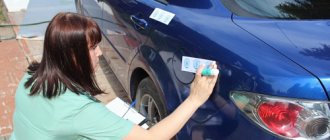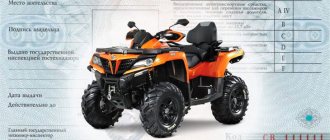The word “arrest” contains a lot of frightening things for an unprepared citizen. Seizure of property, including a car, is no exception. It would seem that it could be difficult - they seized the car, came and took away the car, which means it cannot be used, which means that such a vehicle cannot be sold, which means this is not a problem for anyone other than the owner.
However, the situation is much more complicated - in some cases the seized car will be taken to a special parking lot and even sold, while in others it can be used quite legally. Since there is a question about the seizure of the car, then we will look for the answer. But we warn you, it simply won’t work – you will have to turn to several codes and federal laws at once.
- Can a bank seize a car?
- When can you drive a seized car?
- How to find out who seized a car?
- Act and resolution on seizure
- Option 1. Pay off existing debt
What does a car seizure mean?
According to Russian law, the seizure of a car is a prohibition for the owner to dispose of this property. At the same time, the bailiff, within the framework of enforcement proceedings, has the right to establish different gradations of the ban (from least to greatest): a ban on changing the owner, a ban on operation, seizure of a vehicle with transfer to storage, and arrest for the purpose of sale (sale) with auction to ensure debt repayment.
Already from the definition it is clear that arrest means several different operations, but in all cases the sale of such a car is prohibited, and the purchase and sale agreement drawn up for a car under arrest is void .
Another thing is clear - a ban on exploitation may or may not be implied by the arrest order. This means, under certain conditions, driving a seized car can be completely legal - we’ll talk about this in more detail separately.
What is the difference between an arrest with the right to operate a vehicle and a ban on registration?
These are indeed similar concepts in many ways, but they also have a fundamental difference. A ban on registration is also a restrictive measure within the framework of enforcement proceedings, but, as we have already found out earlier, the sale of such a car is possible.
Selling a seized vehicle, even if such seizure has the potential to be used, is illegal .
There is not a single legal option for the owner to sell the car until the restriction in the form of seizure is lifted from it.
How to check a car for arrest by bailiffs according to the state. number
To obtain information about a vehicle online on the traffic police website, you need to know its VIN code. Checking a car for arrest in the bailiff database by state number in the form of an online request is currently not provided on the websites of the State Traffic Safety Inspectorate and the Federal Bailiff Service. However, there is a legal right of a citizen to contact a government agency with an official request. This can be done either by sending a regular or email letter to the appropriate address, or by filling out the appropriate application form on the department’s website.
Residents of Moscow and the Moscow region can check their car for arrest with bailiffs on the website of the capital's administration https://avtokod.mos.ru. In this case, you will need to know not only the state. car number, but also data from its certificate.
At the time of writing this article, it is not possible for car owners from other regions of the country to check their car for arrest at the FSSP, having received the necessary information in the described way using the specified website.
Therefore, if you need to check a car for restrictions in the bailiff database, without knowing the VIN code of the car, but having its state number, you will have to be smart and first solve the problem of finding out the VIN code from the license plates of the car.
Who can impose it and on what basis?
At first glance, everything is quite simple. There are only three institutions that can use arrest as interim measures:
- court;
- Bailiffs Service;
- Customs.
Customs is a separate and rather specific issue. For the purposes of this proceeding, it will be enough to say that their capabilities are limited to cases of non-compliance with customs legislation when importing vehicles, and we will not return to the issue further in this article.
We will consider the remaining cases - courts and bailiffs - separately, but first about the seizure of vehicles by banks, creditors and other persons to whom the owner of the vehicle has incurred a debt (collectors).
8(800)350-23-68
Dmitry Konstantinovich
Expert of the site "Legal Consultant"
Ask a Question
For those readers who have recently begun to get acquainted with our materials, I will briefly remind you of the difference between the concepts of “debt” and “debt”. Debt is not a basis for sanctions, because assumes the current state of affairs. Debt is already a violation of debt obligations, and the car can be seized for it. The simplest example is a bank loan. Everything you borrowed from the bank is debt. By paying it off on time, you reduce the size of the debt and cannot be punished for having it. However, once a payment is late, a debt arises.
Can a bank seize a car?
Neither banks, nor housing and communal services enterprises, nor the tax service, nor the ex-wife to whom there is arrears of alimony, nor any other creditor (collector) has the legal right to seize property .
But all of the listed persons and organizations have the opportunity to initiate an arrest by starting enforcement proceedings . It is no coincidence that we started with this option to indicate the mandatory participation of bailiffs (bailiffs from the FSSP - the Federal Bailiff Service, including its territorial branches). Please pay special attention to this fact - we will need it later.
For what reasons is it imposed by the court?
There can be many such reasons. To appreciate the scale, let’s look at several basic legal acts that imply the seizure of a car:
- Article 115 of the Criminal Procedure Code of the Russian Federation : within the framework of a civil claim, for arrears of fines, other types of property penalties, including confiscation of property, envisaged by the criminal legislation of Russia.
- Article 140 of the Civil Procedure Code of the Russian Federation : within the framework of a civil claim, incl. when collecting debts on loans, alimony, taxes, housing and communal services, etc.
- Article 91 of the Arbitration Procedural Code of the Russian Federation : in the presence of disputed property.
- Article 80 of the Law on Enforcement Proceedings (Federal Law No. 229) : in addition to the above, it implies the arrest of the car for the purpose of its safety (for example, for further sale).
So, the court has the right to seize property. However, it is not serious to assume that the judge or jury themselves will go to seize the car. Bailiffs exist to execute a court decision .
That is, the court will initiate enforcement proceedings (including issuing enforcement documents), but the actual execution will be handled by the FSSP. And again, we draw special attention to this fact, and then, in fact, we will explain why.
What can bailiffs arrest for?
For all types of debts in the amount of over 3,000 rubles (Part 1.1, Article 80 of Federal Law No. 229). From the above it is clear that whoever initiates the seizure of the car, the arrest itself will be carried out by bailiffs. They are responsible for registering the fact of arrest and its immediate execution.
At the same time, the FSSP also has the right to open enforcement proceedings on its own initiative (or rather, on the initiative of the claimant, but without a corresponding court decision), of course, subject to certain conditions. At the same time, such proceedings can be initiated by a court or another party, but initially do not involve arrest, but within its framework the bailiffs will use arrest as one of the security measures.
The options, as you can see, can be completely different, and the regulation of the actions of the FSSP occurs on the basis of Federal Law No. 229 of October 2, 2007 “On Enforcement Proceedings.”
Who has the right to seize a car and in what cases?
This procedure can be initiated by a decision:
- court when satisfying the claim of any organization or government agency (bank, social security department, etc.);
- customs authorities;
- bailiffs.
There are many reasons why a car is seized. The most common of them are unpaid utilities, overdue loans, debts for alimony or traffic police fines. Also, punitive sanctions can be initiated for non-payment of taxes or for violations of customs clearance of a car (for example, the owner, in order to avoid paying a fee to the state treasury, imports it from abroad for spare parts, etc.).
Types of vehicle impound
This question was already raised at the beginning of the article, it’s time to consider it in more detail. The type of arrest chosen by the bailiff determines both the ability to operate the vehicle during the arrest and the likelihood of completely losing ownership of the car.
The main types of arrest can be deduced from the provisions of Part 4 of Article 80 of Federal Law No. 229:
- Prohibition to dispose of a car . We will consider this option as the least strict, and below we will return to it in more detail.
- Restriction of the right to use . The owner remains with the car, but its use is limited (from partial restrictions to a complete ban on driving such a vehicle).
- Seizure of a vehicle . A seized car becomes inaccessible to the owner - it is transferred for storage to other persons or to specialized organizations.
A logical continuation is the sale of the debtor’s property, but, being a consequence of the introduced prohibitions, this action is not directly an arrest.
When can you drive a seized car?
Let us return again to a question that has already been partially touched upon. Are there options when operating a seized car is legal? Yes it is possible.
In accordance with Part 2 of Article 86 of Federal Law No. 229, seized property can be transferred for storage:
- A special organization that has a corresponding agreement with the FSSP.
- To the claimant.
- Relatives of the debtor.
- To the debtor himself.
At the same time, Part 3 of Article 86 of Federal Law No. 229 gives the bailiff the right to give the person to whom the seized property has been transferred for storage the opportunity to use such a car. to this effect must be drawn up .
Thus, if the seized property has been transferred for storage to the owner-debtor (about which there is relevant information in the decree and the act of seizure), and the bailiff has given written consent to its operation by the debtor, driving the seized car will be considered legal .
8(800)350-23-68
Dmitry Konstantinovich
Expert of the site "Legal Consultant"
Ask a Question
Among other things, this means that the operation of such a vehicle must be carried out in the presence of the listed documents: a resolution / act with a note on transfer to the debtor for storage and consent to use. This is not a legal requirement, but it will help you avoid a lot of trouble when checking on the road.
When can you not seize a car?
If the owner-debtor is a citizen of Russia - an individual (private) person, then there is only one condition under which the vehicle cannot be arrested. In accordance with Part 1 of Article 79 of Federal Law No. 229, this is established by Article 446 of the Code of Civil Procedure of the Russian Federation, which, in turn, in part one, indicates the impossibility of arresting a vehicle if it is necessary due to the debtor’s disability .
For legal entities with debts, the list of such property (in accordance with the same articles of Federal Law No. 229 and the Code of Civil Procedure of the Russian Federation) is established by a separate Federal Law.
How to find out about a car arrest?
We have already found out that the restriction in the form of arrest will in any case be a consequence of enforcement proceedings. That is, such production must exist , which means you can find out about it.
Speaking about checking a car for restrictions, we have already looked in detail at ways to find out the restrictions. Despite the fact that the material focused on restrictions in registration actions, checking through the FSSP database will give results in the event of an arrest, because All information about the various official prohibitions will be provided.
Therefore, we will not return to this methodology in detail again, but we will briefly recall a few basic steps:
- Go to the FSSP website.
- Select "Advanced Search" and a data entry form will open.
- Please indicate your full name, date of birth and region. Click Find.
- Enter the captcha and click "Submit".
- Review the query results.
How to find out who seized a car?
This information may be extremely important because... It is the bailiff who needs to be contacted to resolve issues related to the restrictions imposed. You also need to know the FSSP department to file a complaint (petition) with higher management.
It is not difficult to find out the data - among the information obtained about the arrest using the above method, there will be the necessary parameters. Just keep in mind that when using the mobile version of the site, the table with information does not fit entirely on the screen. Scroll to the right for complete details.
All of the above methods for detecting arrest are relevant in cases where restrictions have not become known in the proper way. Under normal conditions, the resolution and act of seizure of the vehicle must be sent to the debtor no later than the day following the day of their signing (Part 7 of Article 80 of Federal Law No. 229).
How to check a car for arrest with bailiffs using the car's VIN code
A full report on the car for only 129 rubles.
You can save tens of thousands by not buying a car with defects!
If you know the VIN code, you can check the car for free with bailiffs for any restrictions that would prevent it from being registered with the traffic police on the official website of the department www.gibdd.rf. To do this, select the “Vehicle Check” button on the right side of the screen.
Here you can get your car seized by the bailiffs using the VIN code by entering it in the query line that appears.
The provided results of the requests “Checking for restrictions” and “Checking for being wanted” (at the bottom of the page) will contain information about the presence or absence of restrictions on the registration of a vehicle and its possible being on the wanted list.
Important!
It is important to understand that the response to the request provided by the State Traffic Inspectorate does not contain information about the existence of proceedings against the car seller that are pending in court - here, checking the car for arrest on the bailiffs website - fssprus.ru may be useful.
What to do if a vehicle is seized?
As in cases of any other restrictions, the debtor (or a person mistakenly recognized as a debtor) has several ways to resolve the issue:
- Recognize and pay off debt.
- Challenge (appeal) the arrest.
- Accept the loss of property.
We do not take the last case into account. For the rest, we will refer to the material on ways to remove restrictions from the car. The article in the link focuses on cases of bans on registration actions, however, technologically, the methods of appealing against arrest are exactly the same. We will get acquainted with other details of the process further.
How does bailiff seize a car?
Before considering a method for removing a seizure from a car, you need to familiarize yourself with the legal requirements for its imposition in order, among other things, to determine the legality of the measure.
To make it easier to understand, let's imagine the process as a diagram:
A complete outline of the process is provided, however, at each stage the arrest can be lifted (we will return to this in more detail in the next section). Some of the components of the procedure need to be considered in more detail.
Act and resolution on seizure
From the point of view of document flow, you need to understand that there must be two documents:
- Arrest warrant. This is a general document for all cases on the imposition of restrictions, however, an unambiguous note must be made about the fact of arrest (Part 4 of Article 80 of Federal Law No. 229).
- Certificate of seizure of the car. A separate document, including, among other things (parts 5-7 of article 80 of Federal Law No. 229):
- FULL NAME. persons present at the time of drawing up the act.
- An accurate description of the seized property.
- Type and duration of seizure of the car.
- Preliminary assessment of property value.
- Is there a seizure?
- To whom it was transferred for storage.
- Clarification of the responsibilities of the person to whom the car is transferred for storage.
- Statements, remarks, notes, explanations of persons present during the arrest.
An act is drawn up by the bailiff conducting enforcement proceedings. When drawing up the act, witnesses are present and sign the act, as well as the person who is entrusted with the storage of the seized property.
8(800)350-23-68
Dmitry Konstantinovich
Expert of the site "Legal Consultant"
Ask a Question
Let us remind you once again that if there is consent to operate a seized vehicle, a corresponding document must be drawn up and provided to the person who is allowed to drive such a vehicle.
Seizure of documents for cars
When a vehicle is confiscated, its registration documents are also confiscated. Accordingly, upon consent to operate a seized vehicle, the documents must be handed over to the person to whom this consent is given.
It is more difficult when the seizure of documents is used as an independent restrictive measure (without the seizure of a vehicle). Procedurally, the issue is quite controversial, but in any case, such an action must be accompanied by the preparation of relevant documents. In practice, seizure of documents without seizure of a car is used infrequently, due to the already mentioned legal ambiguity.
Exceptions are cases when documents (including registration, state number and/or driver’s license) are evidence in the case, for example, as specified in Article 27.10 of the Code of Administrative Offenses of the Russian Federation. But this is a separate process, which is not discussed in detail in this article.
Seizure of the car
This measure is one of the methods of arrest. In fact, it may mean a temporary transfer of property for storage if the person to whom such storage is entrusted is not the owner (debtor).
However, seizure may also be one of the steps towards the subsequent sale of the vehicle. The fact of seizure is necessarily reflected in the vehicle seizure report.
Bargaining
The sale of seized property in order to compensate for the resulting debt is possible as one of the measures within the framework of enforcement proceedings. The process is procedurally complex, and all the nuances cannot be considered within the framework of one material. But we can say about the main stages:
- The seized property is confiscated and assessed.
- The car is handed over for sale.
- A trade (auction) is organized, the initial cost of the property at which cannot be lower than the assessment carried out at the first stage.
- Restrictions are removed from the sold vehicle.
- The car receives a new legal owner, and the proceeds go to pay off the debt (or part of it).
Each stage is accompanied by specific document flow established by the Law on Enforcement Proceedings and other relevant Federal laws.
Checking the car in the FSSP for a ban on registration actions
Using the official website of the FSSP fssprus.ru, you can check the car for restrictions with bailiffs by obtaining information about enforcement proceedings opened against the citizen from whom you plan to purchase a car.
To do this, when opening the specified site, the visitor will be asked to find out about debts under court decisions and enforcement proceedings by entering the last name, first name, patronymic and date of birth of the person in question in the appropriate request fields.
As a result of a search in the database of enforcement proceedings, the initiator of the request will become aware of their parameters (if any), details of the enforcement document, the responsible department of the bailiffs and a specific executor with contact details (address and telephone number), which can be used for additional information within the framework of current legislation.
Checking a car for restrictions in the FSSP using the VIN code of the car is currently not provided on the service’s website.
How to remove a seizure from a car?
Let's return again to the issue of lifting restrictions. Let us remind you that at this link you can find a detailed description of all possible methods. Here we will briefly dwell on the main ones.
Option 1. Pay off existing debt
Approaches cases when the debtor acknowledges the existing debt and is ready to repay it. The essence of the method is that the necessary funds are transferred to the claimant, which is documented by the bailiff.
The bailiff, having checked the data and agreed on the decision with the claimant, issues a decree to lift the arrest. After entering information into the FSSP database and transferring it to the information systems of other interested departments (for example, traffic police / traffic police), restrictions on vehicles will be lifted.
Option 2. Challenging the arrest
This method is applicable in cases of wrongful arrest. For example, if restrictions are imposed on a vehicle that no longer belongs to the debtor. The main evidence in this case will be confirmation of the transfer of ownership of the vehicle before its arrest .
A complaint about illegal arrest can be submitted to the bailiff in charge of the case, his immediate superiors, etc. right up to the leadership of the FSPP. At the same time, a bona fide purchaser has the right to go to court without going through all the specified stages.
A complaint must be filed within 10 days from the date of arrest. And in case of untimely notification of the ban, within 10 days from the moment the owner learned about this fact.
The result, as in other cases, should be a decision by the bailiff to lift the arrest.
Where can I find out about the ban online?
You can find out about the prohibitions imposed by the FSSP on a car in a number of services. But not everyone should be trusted - not only do the bailiffs themselves have very late information about new car owners, but also the databases may work with a delay.
In this article we will look at instructions for the following services:
- on the official website of the State Traffic Safety Inspectorate - here you can check the availability of registration bans by VIN number more accurately and most up-to-date,
- on the bailiffs website - here is the most complete information.
And these will be 2 different ways to find out the registration restrictions. The fact is that the traffic police website will show whether there are any prohibitions. But in the FSSP you can already find out the reason for their imposition.
But the problem with both sources of information is that you will only be able to find out if there are restrictions on registration actions based on the VIN. You can’t just go and type in a car’s license plate number – official services simply don’t have the appropriate field. But there is a way out of the situation if you only have a state license plate - we just first need to punch through this same VIN number using the registration mark.
Can I use State Services?
No. As of 2021, the official website of the State Administration does not provide services for checking vehicle bans.









